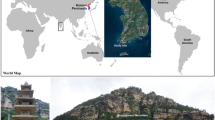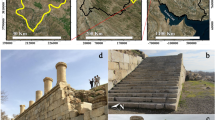Abstract
It is reasonable to study the destruction and preservation of stone relics from a geo-environmental point of view. The Tongtianyan Grottoes, known as “the First Grottoes in Southern China”, are located in the city of Ganzhou, Jiangxi province, China, and are the largest cave temples in eastern China and southern China. The grottoes were carved into sandstone palisades during the period from the late Tang Dynasty (755–763 AD) to the Republic of China (1912–1949 AD). In China, the Danxia landform is a special landform characterized by red sandstone cliffs. Different from the grottoes located in arid climate regions, the Tongtianyan Grottoes have the lowest latitude (25°45′N) among all the grottoes in China, and the stone relics are under a perennially warm and humid environment. The monuments have suffered from various forms of weathering deterioration, which can be summarized as five types: exfoliation, bio-weathering deterioration, crack, erosion, and loss. Detailed investigations have been conducted to analyze the mechanisms of the weathering deterioration of the stone relics based on different aspects of geo-environmental characteristics. The weathering sandstone samples were analyzed using X-ray diffraction and X-ray fluorescence, and the chemical weathering indices (LOI, WPI, and WI) were calculated. We found that there is a boundary zone at a depth of 10 ± 2.5 mm from the surface to the inner rock based on the curves of the chemical weathering indices, and the rock outside of the boundary zone has much stronger weathering than that inside.







Similar content being viewed by others
References
André MF, Phalip B, Voldoire O, Vautier F, Géraud Y, Benbakkar M, Constantin C, Huber F, Morvan G (2011) Weathering of sandstone lotus petals at the Angkor site: a 1,000-year stone durability trial. Environ Earth Sci 63:1723–1739. doi:10.1007/s12665-010-0734-9
André MF, Vautier F, Voldoire O, Roussel E (2014) Accelerated stone deterioration induced by forest clearance around the Angkor temples. Sci Total Environ 493:98–108. doi:10.1016/0022-4804(89)90110-8
Barzoi SC, Luca AC (2013) Significance of studying the petrography and mineralogy of the geological environment of old rupestrian churches to prevent their deterioration. A case study from the South Carpathians. J Cult Herit 14:163–168. doi:10.1016/j.culher.2012.05.004
Duane MJ (2006) Coeval biochemical and biophysical weathering processes on Quaternary sandstone terraces south of Rabat (Temara), northwest Morocco. Earth Surf Proc Land 31:1115–1128. doi:10.1002/esp.1313
Fitzner B, Heinrichs K (2002) Damage diagnosis on stone monuments—weathering forms, damage categories and damage indices. In: Prikryl R, Viles HA (eds) Understanding and managing stone decay, Proceeding of the International Conference “Stone weathering and atmospheric pollution network (SWAPNET 2001)”. The Karolinum, Prague, pp 11–56
Guo F, Jiang GH (2015) Investigation into rock moisture and salinity regimes: implications of sandstone weathering in Yungang Grottoes, China. Carbonates Evaporites 30:1–11. doi:10.1007/s13146-014-0191-8
Gupta AS, Rao SK (2001) Weathering indices and their applicability for crystalline rocks. Bull Eng Geol Env 60:201–221. doi:10.1007/s100640100113
Huang KZ (1992) The environmental geological problems in Chinese cave temples protection. Refer to: the protection of monuments and environmental geology, 1st edn. China University of Geosciences Press, Wuhan, pp 1–8 (in Chinese)
Jiang GH, Guo F, Polk JS (2015) Salt transport and weathering processes in a sandstone cultural relic, North China. Carbonates Evaporites 30:69–76. doi:10.1007/s13146-014-0202-9
Li HS (2011) Character and evaluation method of historical rock deterioration. Ph.D. Thesis, China University of Geosciences, Beijing, China, p 14 (in Chinese)
Li HS, Wang WF, Wu FS, Zhan HT, Zhang GB, Qiu F (2014) A new sand-wedge–forming mechanism in an extra-arid area. Geomorphology 211:43–51. doi:10.1016/j.geomorph.2013.12.028
Lian B, Chen Y, Zhu LJ, Yang RD (2008) Progress in the study of the weathering of carbonate rock by microbes. Earth Sci Front (China University of Geosciences, Beijing; Peking University) 15(6):090–099 (in Chinese)
Liu CY, He MC (2011) Research on the sensitive chemical weathering indices to rock weathering. Earth and Environment 393:349–354. doi:10.14050/j.cnki.1672-9250.2011.03.020 (in Chinese)
Liu RZ, Zhang BJ, Zhang H, Shi MF (2011) Deterioration of Yungang Grottoes: diagnosis and research. J Cult Herit 12:494–499. doi:10.1016/j.culher.2011.03.008
Machill S, Althaus K, Krumbein WE, Steger WE (1997) Identification of organic compounds extracted from black weathered surfaces of Saxonean sandstones, correlation with atmospheric input and rock inhabiting microflora. Org Geochem 27:79–97. doi:10.1016/S0146-6380(97)00041-7
Mccabe S, Mckinley JM, Gomez-Heras M, Smith BJ (2011) Dynamical instability in surface permeability characteristics of building sandstones in response to salt accumulation over time. Geomorphology 130:65–75. doi:10.1016/j.geomorph.2010.10.006
Netoff DI, Chan MA (2009) Aeolian activity at a giant sandstone weathering pit in arid south-central Utah. Earth Surf Proc Land 34:99–108. doi:10.1002/esp.1697
Paradise TR (2013) Assessment of tafoni distribution and environmental factors on a sandstone djinn block above Petra, Jordan. Appl Geogr 42:176–185. doi:10.1016/j.apgeog.2013.04.011
Peng H, Pan ZX, Qiu ZW (2015) Weathering pattern and development process of bedding-controlled caves at Mt. Danxiashan, China. Zeitschrift für Geomorphologie Suppl Issues 59(1):165–182. doi:10.1127/zfg_suppl/2015/S-00179
Pope GA, Meierding TC, Paradise TR (2002) Geomorphology’s role in the study of weathering of cultural stone. Geomorphology 47:211–225. doi:10.1016/S0169-555X(02)00098-3
Přikryl R, Melounová L, Vařilová Z, Weishauptová Z (2007) Spatial relationships of salt distribution and related physical changes of underlying rocks on naturally weathered sandstone exposures (Bohemian Switzerland National Park, Czech Republic). Environ Geol 52:409–420. doi:10.1007/s00254-006-0589-2
Shen GJ, Wang W, Wang Q, Zhao JX, Collerson K, Zhou CL, Tobias PV (2002) U-Series dating of Liujiang hominid site in Guangxi, Southern China. J Hum Evol 43:817–829. doi:10.1053/jhev.2002.0601
Siedel H, Pfefferkorn S, Plehwe-Leisen EV, Leisen H (2010) Sandstone weathering in tropical climate: results of low-destructive investigations at the temple of Angkor Wat, Cambodia. Eng Geol 115:182–192. doi:10.1016/j.enggeo.2009.07.003
Smith BJ, Srinivasan S, Gomez-Heras M, Basheer PAM, Viles HA (2011) Near-surface temperature cycling of stone and its implications for scales of surface deterioration. Geomorphology 130:76–82. doi:10.1016/j.geomorph.2010.10.005
Song JT (2011) Environmental geology problems of the Thousand Buddha Cliff of Guangyuan stony cultural relies. Ph.D. Thesis, Northwest University, Xi’an, China, pp 2–3 (in Chinese)
Stück H, Plagge R, Siegesmund S (2013) Numerical modeling of moisture transport in sandstone: the influence of pore space, fabric and clay content. Environ Earth Sci 69:1161–1187. doi:10.1007/s12665-013-2405-0
Topal T (2002) Quantification of weathering depths in slightly weathered tuffs. Environ Geol 42:632–641. doi:10.1007/s00254-002-0566-3
Turkington AV, Paradise TR (2005) Sandstone weathering: a century of research and innovation. Geomorphology 67:229–253. doi:10.1016/j.geomorph.2004.09.028
Uchida E, Ogawa Y, Maeda N, Nakagawa T (1999) Deterioration of stone materials in the Angkor monuments, Cambodia. Eng Geol 55:101–112. doi:10.1016/S0165-1250(00)80027-9
Xu S, Sirieix C, Ferrier C, Lacanette-Puyo D, Riss J, Malaurent P (2015) A geophysical tool for the conservation of a decorated cave—a case study for the Lascaux Cave. Archaeol Prospect 22:283–292. doi:10.1002/arp.1513
Zhang H, Shi MF, Shen W, Li ZG, Zhang BJ, Liu RZ, Zhang RP (2013) Damage or protection? The role of smoked crust on sandstones from Yungang Grottoes. J Archaeol Sci 40:935–942. doi:10.1016/j.jas.2012.09.031
Zhu C, Peng H, Ouyang J, Hu ZN, Li L (2010) Rock resistance and the development of horizontal grooves on Danxia slopes. Geomorphology 123:84–96. doi:10.1016/j.geomorph.2010.07.002
Acknowledgements
This work was supported by the National Natural Science Foundation of China (Grant No. 41472263). The authors also express their gratitude to the staff of the Tongtianyan Grottoes scenic spot in Ganzhou for their support to the survey. And special thanks to the editors and reviewers for their suggestions and encouragement.
Author information
Authors and Affiliations
Corresponding author
Rights and permissions
About this article
Cite this article
Wang, K., Xu, G., Li, S. et al. Geo-environmental characteristics of weathering deterioration of red sandstone relics: a case study in Tongtianyan Grottoes, Southern China. Bull Eng Geol Environ 77, 1515–1527 (2018). https://doi.org/10.1007/s10064-017-1128-y
Received:
Accepted:
Published:
Issue Date:
DOI: https://doi.org/10.1007/s10064-017-1128-y




